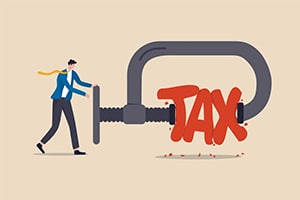
Business Advisory Services
Everything you need to help you launch your new business entity from business entity selection to multiple-entity business structures.
Hey - Our site just had a makeover and we are sorting through the hiccups!
Hey - Our site just had a makeover and we are sorting through the hiccups!

Everything you need to help you launch your new business entity from business entity selection to multiple-entity business structures.

Designed for rental property owners where WCG CPAs & Advisors supports you as your real estate CPA.

Everything you need from tax return preparation for your small business to your rental to your corporation is here.

WCG’s primary objective is to help you to feel comfortable about engaging with us
Table Of Contents
![[page_title]](https://wcginc.com/wp-content/uploads/WCG-Placeholder-h-300x183-1.jpg)
Nationally, the average top-1% income is $1.3 million, about 26 times the average of the bottom 99%.

The United States is enjoying an era of unprecedented wealth and prosperity. Economic output and household incomes are at all-time highs, while unemployment is at its lowest level in well over a decade. However, the growth has not benefited all Americans equally, and in much of the country, wealth is becoming increasingly concentrated in the hands of a few.
From the end of World War II through the early 1970s, the average income growth of the bottom ninety-nine percent of earners roughly tripled the 34 percent growth rate among the wealthiest one percent.
Since, however, the strengthening of the middle class has ground nearly to a halt, while the wealth of the one percent has grown exponentially.
The average income for the top one percent spiked by 216.4 percent from 1973 to 2007, but it increased by just 15.4 percent for all other earners. From 2009 to 2015, the average income for the wealthiest Americans grew by 33.9 percent, more than triple the income growth of 10.3 percent among the remaining ninety-nine percent.
Today, more so than in the decades immediately following World War II, being among the top earners not only helps ensure a comfortable life, but also greatly increases earning potential and the ability to amass a fortune.
Any family earning at least $422,000 a year ranks among the top one percent of earners nationwide. However, as income levels vary by state so too does the amount it takes to be a one-percenter.
24/7 Wall Street reviewed data compiled by the Economic Policy Institute, a nonprofit nonpartisan think tank, to identify the minimum income threshold of the top one percent of earners in each state.
According to the Economic Policy Institute, growing income inequality is attributable to a number of factors. In earlier decades of the last century, strong unionization in industries like manufacturing, construction, and transportation, and a regularly rising minimum wage coupled with a cultural and legal environment that capped executive compensation helped ensure favorable wage growth for the vast majority of Americans.
Today, many of those conditions no longer exist and union participation has hit lows not seen since before the Great Depression, the federal minimum wage has less buying power than it did half a century ago, and CEO compensation has increased exponentially in recent decades.
Through investments and ownership of assets such as real estate and company stocks, wealthier Americans are able to expand their wealth far faster than those of lesser means.
The states with the highest thresholds of what it takes to be in the one percent also generally have the greatest degree of income inequality. In New York, a state where the one percent earns at least $550,174 a year, the average income among one percenters is $2.2 million – 44 times the average income of $49,617 among the bottom ninety-nine percent. No state has greater inequality. For comparison, the average one percenter on a national scale earns $1.3 million a year, 26.3 times the average income of $50,107 among the remaining ninety-nine percent.
The states with the wealthiest one-percenters – generally the same states with the greatest income inequality – tend to have higher educational attainment rates. College graduates are more likely to earn higher incomes, but access to a four-year college degree can depend largely on family incomes. This structure serves to reinforce the concentration of wealth at the top.
Of the 10 states with the highest income threshold for the top one percent, nine are home to a larger than typical share of adults with a bachelor’s degree than the national share. Similarly, nine of the 10 states with the lowest income threshold for the top one percent have a lower bachelor’s degree attainment rate than the comparable national rate of 31.3 percent.
To identify the annual income necessary to be in the top 1 percent of earners in each state, 24/7 Wall Street reviewed “The New Gilded Age: Income Inequality in the U.S. by State,” an Economic Policy Institute report published in July 2018. Income figures are from the IRS and are for tax units – which could be a single adult or married couple – and are for 2015. The share of adults with a bachelor’s degree came from the U.S. Census Bureau’s American Community Survey and are for 2016.
About $422,000 per year.
Connecticut, New Jersey, Massachusetts, New York, and California.
Mississippi, Arkansas, New Mexico, and West Virginia.
Factors include lower union participation, stagnant minimum wages, and rising CEO compensation.
Around 216% from 1973 to 2007.
About 15% over the same period.
Yes, states with more college graduates often have higher top-1% income levels.
Roughly 26 times more.
Yes, through investments in stocks, real estate, and business ownership.
No, it varies widely, with the greatest gaps in states with high top-1% incomes.

Want to talk to us about tax return preparation, tax planning and strategy, and all the other things that go with it? We are eager to assist! The button below takes you to our Getting Started webpage, but if you want to talk first, please give us a call at 719-387-9800 or schedule an discovery meeting.
Jason Watson, CPA is a Partner and the CEO of WCG CPAs & Advisors, a boutique consultation and tax preparation CPA firm serving clients nationwide with 7 partners and over 90 tax and accounting professionals specializing in small business owners and real estate investors located in Colorado Springs.
He is the author of Taxpayer’s Comprehensive Guide on LLC’s and S Corps and I Just Got a Rental, What Do I Do? which are available online and from mostly average retailers.
Table Of Contents

Tax planning season is here! Let's schedule a time to review tax reduction strategies and generate a mock tax return.

Tired of maintaining your own books? Seems like a chore to offload?
Did you want to chat about this? Do you have questions about us? Let’s chat!
The tax advisors, business consultants and rental property experts at WCG CPAs & Advisors are not salespeople; we are not putting lipstick on a pig expecting you to love it. Our job remains being professionally detached, giving you information and letting you decide within our ethical guidelines and your risk profiles.
We see far too many crazy schemes and half-baked ideas from attorneys and wealth managers. In some cases, they are good ideas. In most cases, all the entities, layering and mixed ownership is only the illusion of precision. As Chris Rock says, just because you can drive your car with your feet doesn’t make it a good idea. In other words, let’s not automatically convert “you can” into “you must.”
Let’s chat so you can be smart about it.
We typically schedule a 20-minute complimentary quick chat with one of our Partners or our amazing Senior Tax Professionals to determine if we are a good fit for each other, and how an engagement with our team looks. Tax returns only? Business advisory? Tax strategy and planning? Rental property support?

Everything you need to help you launch your new business entity from business entity selection to multiple-entity business structures.

Designed for rental property owners where WCG CPAs & Advisors supports you as your real estate CPA.

Everything you need from tax return preparation for your small business to your rental to your corporation is here.

WCG’s primary objective is to help you to feel comfortable about engaging with us

